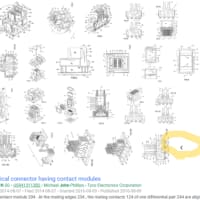US11289299(UNIV ARIZONA STATE [US])
[0084] Ion microscope performance:
【0067】
[イオン顕微鏡の性能]
The ion microscope uses an imaging approach called ion microscopy,
イオン顕微鏡は、イオン顕微鏡法と称される結像(imaging)アプローチを用いる。
in which the sample is illuminated by a primary ion beam rastered over a several hundred micrometer square area and imaging is accomplished using stigmatic ion lenses operating on the sputtered secondary ion beam.
該アプローチにおいて、試料は数百マイクロメートル四方の領域にわたりラスター化した一次イオンビームにより照射され、結像はスパッタされた二次イオンビームで動作する無収差イオンレンズを用いて行われる。
Thus, extremely small focused primary ion beams are not required for imaging.
それゆえ、結像には、極端に小さい集光一次ビームは不要である。
Instead, the highest achievable total currents are desired, together with the highest achievable current density in a focused beam.
代わりに、集光ビームの実現可能な最も高い電流密度とともに、実現可能な最も高い総電流が望まれる。
A major analytical use of the ion microscope is for “depth profiling”,
イオン顕微鏡の主な分析用途は、「深さ方向分析」であり、
in which several ion species in the sample are monitored as a function of time as a flat-bottomed crater is eroded into the sample.
この分析用途では、試料中のいくつかのイオン種が、底が平坦なクレータが試料に侵食していく際の時間の関数として監視される。
EP2950832(GORE & ASS [US])
X-ray photoelectron spectroscopy with depth profiling (XPS) (primer and coating composition)
【0280】
深さ方向分析を含むX線光電子分光法(XPS)(プライマー及びコーティングの組成)
X-ray Photoelectron Spectroscopy (XPS or ESCA) is the most widely used surface characterization technique providing non-destructive chemical analysis of solid materials.
X線光電子分光法(XPS又はESCA)は、固対材料の非破壊の化学分析を提供する最も広く用いられている表面のキャラクタリゼーション法である。
Samples are irradiated with mono-energetic X-rays causing photoelectrons to be emitted from the top 1 - 10nm of the sample surface.
サンプルを、サンプル表面の上端1~10nmから放出されるべき光電子を発生させる単一エネルギーのX線で照射する。
An electron energy analyzer determines the binding energy of the photoelectrons.
電子エネルギー分析は、光電子の結合エネルギーを評価する。
Qualitative and quantitative analysis of all elements except hydrogen and helium is possible, at detection limits of∼0.1 - 0.2 atomic percent.
水素及びヘリウムを除く全ての元素の定性的及び定量的な分析が可能であり、検出限界は約0.1~0.2アトミックパーセントである。
Analysis spot sizes range from 10µm to 1.4mm.
分析のスポットサイズは10μm~1.4mmの範囲である。
It is also possible to generate surface images of features using elemental and chemical state mapping.
元素及び化学状態のマッピングを用いて性状の表面イメージを作製することも可能である。
Depth profiling is possible using angle-dependent measurements to obtain non-destructive analyses within the top 10nm of a surface, or throughout the coating depth using destructive analysis such as ion etching.
深さ方向分析は、角度依存測定を用いて表面の上端10nm以内の非破壊分析、又はイオンエッチング等の破壊分析を用いてコーティング深さ全幅について得ることが可
能である。
EP3864436(UNIV COURT UNIV OF EDINBURGH [GB])
[0003] Time of flight (ToF) based imaging is used in a number of applications including range finding, depth profiling, and 3D imaging (e.g., LIDAR, also referred to herein as lidar).
【0003】
タイム・オブ・フライト(ToF:Time of flight)ベースのイメージングは、(例えば、LIDAR、本明細書ではライダーとも称する)測距、深さ方向分析及び3Dイメージングを含む多数の用途で使用される。
Direct time of flight measurement includes directly measuring the length of time between emitting radiation and sensing the radiation after reflection from an object or other target.
直接ToF測定は、照射光の放出と物体又は他の標的からの反射後の照射光の検知との間の時間の長さを直接測定することを含む。
From this, the distance to the target can be determined.
この測定から、標的までの距離を求めることができる。


























※コメント投稿者のブログIDはブログ作成者のみに通知されます